Château St-Ferriol
Late Medieval Castle in the South of France
History of the Château de St-Ferriol

 Relatively
little is known about the history of the Château de St-Ferriol.
Local records were lost in a fire in the early eighteenth century,
and whatever remained seems to have been deliberately destroyed
during the French revolution. From the few remaining records and
architectural clues, we believe that we have a reasonably good
outline of the history of the Seigneurie, Village and Château
of St-Ferriol. Relatively
little is known about the history of the Château de St-Ferriol.
Local records were lost in a fire in the early eighteenth century,
and whatever remained seems to have been deliberately destroyed
during the French revolution. From the few remaining records and
architectural clues, we believe that we have a reasonably good
outline of the history of the Seigneurie, Village and Château
of St-Ferriol.
Some buildings existed on the present site before 1300, but the
principal Château at that period was some distance away
along a ridge called Le Dent. This Château seems to have
fallen into disuse after the Cathar period, and according to a
strong local tradition the present Château was build from
stones removed from the old one.
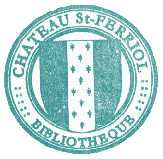 From architectural clues, we can date the present building to
around 1570. The original style appears to have been late medieval
- not that unusual in this area even at such a late date. The
barons of St-Ferriol were caught up in the Wars of Religion soon
after the Château was built, and it is possible that the
building was damaged in those wars as it was comprehensively restructured
soon after, around 1600, in the early Renaissance style.
From architectural clues, we can date the present building to
around 1570. The original style appears to have been late medieval
- not that unusual in this area even at such a late date. The
barons of St-Ferriol were caught up in the Wars of Religion soon
after the Château was built, and it is possible that the
building was damaged in those wars as it was comprehensively restructured
soon after, around 1600, in the early Renaissance style.
From notarial records we know something about the barons of St-Ferriol,
the family that build the Château. Their name was de Plaigne
and their ancestors had been key participants in some of the major
events of the Cathar Crusades. One of the few documents we have
is a letter from the executors of one of the Barons de St-Ferriol,
dated 1588 addressed to the local authorities, explaining that
"françois de plaigne siegneur de st-ferriol", had died
fighting in the wars, pointing out that his castle was now ungarded
as his eldest child was only five years old, emphasising the castle's
strategic importance in a raging war zone, and asking the local
commander to provide a garrison.
The family died out in the following century, after which the
Château passed through a number of hands, without ever being
refurbished. It therefore retains many original features, and
it was for this reason that it was inscrit as a Monument
Historique at the end of the twentieth century.
This is a very brief outline. More detail is given below - representing
almost as much as we know. There is still much research to do.
Château de St-Ferriol - Detailed History (Seigneurie, Village
and Château)
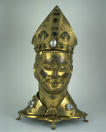
 A
number of saints bear the name Ferréol or Ferriol (Ferreolus,
man-of-iron). The village of St Ferriol in the Aude is named after
a tribune of the armies of Vienne (Dauphiné) who was supposedly
arrested and tortured by the Romans for having welcomed Saint
Julien de Brioude. Ferriol is said to have refused to persecute
Christians and, despite God's efforts to save him, was captured
and decapitated around AD 304. His feast is the 18th September.
It is likely that he and his story were invented some centuries
later, like so many other similar persecution stories which became
popular in the Middle Ages. A
number of saints bear the name Ferréol or Ferriol (Ferreolus,
man-of-iron). The village of St Ferriol in the Aude is named after
a tribune of the armies of Vienne (Dauphiné) who was supposedly
arrested and tortured by the Romans for having welcomed Saint
Julien de Brioude. Ferriol is said to have refused to persecute
Christians and, despite God's efforts to save him, was captured
and decapitated around AD 304. His feast is the 18th September.
It is likely that he and his story were invented some centuries
later, like so many other similar persecution stories which became
popular in the Middle Ages.
A number of Villages in France are called St-Ferréol but
the one in the Aude is called St-Ferriol (reflecting the Occitan
pronunciation). The location is first mentioned in 1155, when
ecclesiastical records indicate that a church dedicated to Sanctus
Ferreolus existed on the site. It is unlikely that there were
any substantial buildings there. At this time the principal settlements
in the area would have been at Le Dent (to the East), Moissan
(to the North West), and Granès (to the North). The buildings
at Le Dent and at Moissan have both since disappeared, though
the sites are still known. Throughout the early Middle Ages the
area would have been owned by the family of Niort (or Aniort),
viscounts of the plateau de Sault, or their cousins the seigneurs
of Albedun (modern day Le Bèzu). Both of these families had known
Cathar sympathies in the late twelfth and early thirteenth centuries.
A Cathar bishop, Guilabert de Castres, took refuge at the Chateau
of Albedun in 1226.

 Both
the de Niort and d'Albedun families were dispossessed after the
Cathar Crusade because of their Cathar links, and their lands
were given to the family of de Voisins, Pierre de Voisins having
been a principal lieutenant of Simon de Montfort during the Crusade
When the Razès was annexed to France in the late thirteenth century,
it became necessary to defend the area against the Kings of Aragon.
As well as fortifying border castles, the French kings established
defensible villages to guard vulnerable valleys. Around 1300 a
new bastide was constructed near Parahou. This bastide received
the name St-Louis, after the late king Louis IX who had been cannonised
in 1297. Both
the de Niort and d'Albedun families were dispossessed after the
Cathar Crusade because of their Cathar links, and their lands
were given to the family of de Voisins, Pierre de Voisins having
been a principal lieutenant of Simon de Montfort during the Crusade
When the Razès was annexed to France in the late thirteenth century,
it became necessary to defend the area against the Kings of Aragon.
As well as fortifying border castles, the French kings established
defensible villages to guard vulnerable valleys. Around 1300 a
new bastide was constructed near Parahou. This bastide received
the name St-Louis, after the late king Louis IX who had been cannonised
in 1297.
Under Louis' successor Philippe le Bel further bastides were
constructed at Saint-Julia, Saint-Ferriol, Saint-Eugenie, and
Saint-Just.
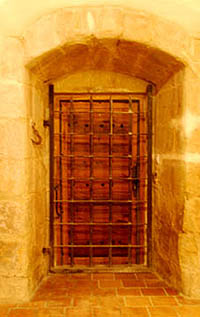  Saint-Julia,
Saint-Ferriol, Saint-Eugenie seems to have been part of a single
seigneurie which included Laval (Laval St-Nazaire), Espinette,
and later Granès. It was sometimes referred to as the seigneurie
of St-Ferriol and sometimes the seigneurie of St-Julia - possible
depending upon the location of the Seigneur's residence. The Rector
of St-Ferriol (Rector Sancti Ferrioli) is mentioned in
1347 and the bastide and parish of St-Ferriol (bastide & paroisse)
are mentioned in 1360. Saint-Julia,
Saint-Ferriol, Saint-Eugenie seems to have been part of a single
seigneurie which included Laval (Laval St-Nazaire), Espinette,
and later Granès. It was sometimes referred to as the seigneurie
of St-Ferriol and sometimes the seigneurie of St-Julia - possible
depending upon the location of the Seigneur's residence. The Rector
of St-Ferriol (Rector Sancti Ferrioli) is mentioned in
1347 and the bastide and parish of St-Ferriol (bastide & paroisse)
are mentioned in 1360.
A branch of the family of Niort had settled in the Rebenty valley,
at a place known as Castelport, near modern Joucou, where the
Niorts had had a château for several centuries. This branch had
adopted the title of de Castelport, and it was one of their number,
Guillaume de Castelport, who had built the new bastide at St-Louis
on land that had previously belonged to the Niort family. It likely
that this family were also involved in the construction of the
other bastides in the area. Amongst their possessions were fiefs
near Esperaza, Cals (modern Laval), and St-Ferriol - possibly
these were all the same fief as they are never mentioned together.
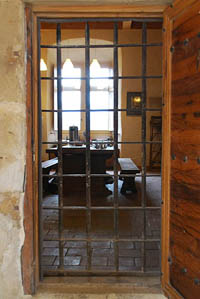  In
1389 Hughes de Castelport was co-seigneur of St-Ferriol along
with Etienne Marty, seigneur de Voisins. Towards the end of the
century Hugh's property was inherited by Gaucerand de Marsa, who
passed it on to Jeanne de Castelport. She sold most of it to Jean
de Castelport, but the fief at St-Ferriol and Espinet was sold
to Etienne Marty in 1393. A few years later we find Noble Antoine
Martin described as Seigneur de St-Julia. Antoine Martin had a
daughter Giraude, who married Sicard de Plaigne, co-seigneur de
Plaigne. Sicard came from another family who had been dispossessed
because of their Cathar connections (two of them had been involved
in the massacre at Avignonet in 1242, and had also been members
of the garrison at Montsegúr during the siege of 1243-44). In
1389 Hughes de Castelport was co-seigneur of St-Ferriol along
with Etienne Marty, seigneur de Voisins. Towards the end of the
century Hugh's property was inherited by Gaucerand de Marsa, who
passed it on to Jeanne de Castelport. She sold most of it to Jean
de Castelport, but the fief at St-Ferriol and Espinet was sold
to Etienne Marty in 1393. A few years later we find Noble Antoine
Martin described as Seigneur de St-Julia. Antoine Martin had a
daughter Giraude, who married Sicard de Plaigne, co-seigneur de
Plaigne. Sicard came from another family who had been dispossessed
because of their Cathar connections (two of them had been involved
in the massacre at Avignonet in 1242, and had also been members
of the garrison at Montsegúr during the siege of 1243-44).
Sicard already had fiefs at St-Louis. Presumably through his
wife's inheritance his family acquired the seigneurie of St-Ferriol/St-Julia.
We find Sicard and Guiraud's son, Guillaume-Arnaud de Plaigne
described as Seigneur de St-Ferriol as well as other places. Guillaume-Arnaud
had two sons, the elder of whom, Sicard, inherited seigneuries
at Plaigne (near Belpech), Castrofizel, and Marsa. The younger
son, Philippe, became seigneur de St-Ferriol, and the seigneurie
stayed in the cadet branch of the family, passing from Philippe
to Guillaume-Arnaud, to Michel, born around 1493.
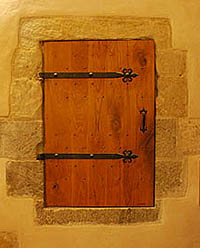  In
the fourteenth century the fief of Sainte Eugénie became
the property "indivise" of Jean de Hautpoul, seigneur
of Granès and of Montazels (nearby villages), and of Michel
de Plagne, seigneur de Saint Ferriol et de Saint-Julia. An acte
of 1522 confirms the division. One part retaining the name Sainte
Eugénie, is attributed to the seigneur de Saint Ferriol,
while the other, apparently under the name of Robert Guiraud remained
the property of the de Hautpouls. In
the fourteenth century the fief of Sainte Eugénie became
the property "indivise" of Jean de Hautpoul, seigneur
of Granès and of Montazels (nearby villages), and of Michel
de Plagne, seigneur de Saint Ferriol et de Saint-Julia. An acte
of 1522 confirms the division. One part retaining the name Sainte
Eugénie, is attributed to the seigneur de Saint Ferriol,
while the other, apparently under the name of Robert Guiraud remained
the property of the de Hautpouls.
The fief of Sainte Eugénie included a château, long
fallen into ruin, called le Château de l'Adent (or Château
de la Dent) - it is thought to take its name from the tooth-like
rock formations of the hill on which it stands - still called
Le Dent. In 1632 it was to be the object of an "assignat"
in favour of Pierre de Voisins.
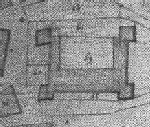  The
present chateau de St-Ferriol was probably built by Michel de
Plaigne, or his son Arnaud-Guillaume. Certainly a "chateau" is
mentioned in an inventory taken in 1570 at the death of Françoise
de Narbonne (Michel's wife and Arnaud-Guillaume's mother). According
to local legend it was built from stones brought from the nearby
ruined chateau of Le Dent. (Perhaps Michel de Plagne bought the
ruined chateau for exactly this purpose). The
present chateau de St-Ferriol was probably built by Michel de
Plaigne, or his son Arnaud-Guillaume. Certainly a "chateau" is
mentioned in an inventory taken in 1570 at the death of Françoise
de Narbonne (Michel's wife and Arnaud-Guillaume's mother). According
to local legend it was built from stones brought from the nearby
ruined chateau of Le Dent. (Perhaps Michel de Plagne bought the
ruined chateau for exactly this purpose).
|
One of the sixteen surviving canoniers
|
On the winter, the canoniers are
blocked up by specially made wooden plugs
|
|
|
|
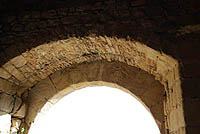  Originally
the new Chateau followed a rectangular plan, with a bastion at
each corner to provide covering fire to all external walls, as
can be seen from the surviving canoniers (the successors to earlier
arrow slits). Originally the main (indeed only) entrance would
have been the large gateway to the East, now unused. Slate roof
slates found in the courtyard suggest that it originally had a
steep state roof, increasing its height by around five metres.
The style echoes that of a family of grander châteaux built at
around the same time, and indeed the ideas may have come from
the de Rougier family who were Barons of Ferrals and who built
a magnificent château there around 1565. Originally
the new Chateau followed a rectangular plan, with a bastion at
each corner to provide covering fire to all external walls, as
can be seen from the surviving canoniers (the successors to earlier
arrow slits). Originally the main (indeed only) entrance would
have been the large gateway to the East, now unused. Slate roof
slates found in the courtyard suggest that it originally had a
steep state roof, increasing its height by around five metres.
The style echoes that of a family of grander châteaux built at
around the same time, and indeed the ideas may have come from
the de Rougier family who were Barons of Ferrals and who built
a magnificent château there around 1565.
.jpg)  From
Arnaud-Guillaume, also castellan of Quillan, the seigneurie de
St-Ferriol, now referred to as a barony, passed to his son François
de Plaigne. In 1584 François married his cousin Pierrette Le Roy
de la Roquette, Pierrette's mother's parents being Michel de Plaigne
and Françoise de Narbonne. François took an active part in the
wars of religion raging in the area at this time, deputising for
the Duc de Joyeuse on occasion. He was mortally wounded at the
Battle of Cruzy in 1586, leaving a wife, young children, and an
undefended chateau in a raging war zone. A request was made for
soldiers to garrison the chateau de St-Ferriol, described in the
document of 1588 as "fort et tenable" . The request was granted,
but is not known whether the chateau was ever attacked. No war
damage is evident, but the fact that major rebuilding works were
undertaken soon after suggests that it was. On the hand the alterations
turned a defensible late medieval building into a comfortable
early renaissance one, which was the fashion of the period. From
Arnaud-Guillaume, also castellan of Quillan, the seigneurie de
St-Ferriol, now referred to as a barony, passed to his son François
de Plaigne. In 1584 François married his cousin Pierrette Le Roy
de la Roquette, Pierrette's mother's parents being Michel de Plaigne
and Françoise de Narbonne. François took an active part in the
wars of religion raging in the area at this time, deputising for
the Duc de Joyeuse on occasion. He was mortally wounded at the
Battle of Cruzy in 1586, leaving a wife, young children, and an
undefended chateau in a raging war zone. A request was made for
soldiers to garrison the chateau de St-Ferriol, described in the
document of 1588 as "fort et tenable" . The request was granted,
but is not known whether the chateau was ever attacked. No war
damage is evident, but the fact that major rebuilding works were
undertaken soon after suggests that it was. On the hand the alterations
turned a defensible late medieval building into a comfortable
early renaissance one, which was the fashion of the period.
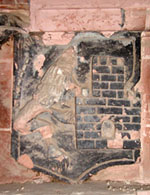  The
eldest son of François de Plaigne and Pierrette Le Roy de la Roquette
was Barthélémy de Plaigne. He married Anne de Mauléon in 1610,
but died without issue. A curious fireplace on the top floor of
the château bears an achievement of arms which appear to represent
a combination those of de Plaigne (presumed to be a castle) and
those of de Mauleon (a lion). An inscription reads: The
eldest son of François de Plaigne and Pierrette Le Roy de la Roquette
was Barthélémy de Plaigne. He married Anne de Mauléon in 1610,
but died without issue. A curious fireplace on the top floor of
the château bears an achievement of arms which appear to represent
a combination those of de Plaigne (presumed to be a castle) and
those of de Mauleon (a lion). An inscription reads:
NOBLE
ANNE DE MAVLEON + IN CALCEAT COR MEUM AMORE DOMINI: + 1630: +
FERRANDUS: FECIT
Which means NOBLE ANNE DE MAULEON + THE LOVE OF GOD BURNS IN
MY HEART: + 1630: + FERRAND MADE ME. The words IN CALCEAT COR
MEUM AMORE DOMINI closely resemble those of the Stabat Mater -
a prayer placed in the mouth of the Virgin Mary grieving for her
recently dead son. There is known to have been an unusually severe
outbreak of the plague in the area in 1629, and it is possible
that Barthélémy and Anne's heir or heirs died of it, leaving Anne
childless and too old to bear more children. Did Anne make a conscious
connection between Mary's maternal grief and her own, giving her
the idea for the inscription? We may never know for certain. In
any case this branch of the de Plaigne family would die out after
this generation, followed shortly afterwards by the senior branch
of the family, whose property at Plaigne and in the Rebenty valley
(including Castelport) would pass through marriage to the Comte
du Faure de Coustos.
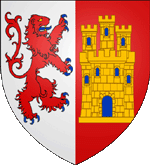  Pierrette,
the widow of François de Plaigne, remarried in 1591. Her new husband
was Sicard du Vivier de Sarraute, a younger son of Nicolas du
Vivier, Seigneur de Sarraute, born of a cadet branch of the du
Viver family. Sicard adopted the style of Seigneur de St-Ferriol,
perhaps while he was acting as regent for the infant Barthélémy
de Plaigne, as well as step-father. Louis du Vivier, the son and
heir of Sicard and Pierrette, would later be referred to as co-seigneur
de St-Ferriol - he was after all the great-grandson of Michel
de Plaigne through his mother. Pierrette,
the widow of François de Plaigne, remarried in 1591. Her new husband
was Sicard du Vivier de Sarraute, a younger son of Nicolas du
Vivier, Seigneur de Sarraute, born of a cadet branch of the du
Viver family. Sicard adopted the style of Seigneur de St-Ferriol,
perhaps while he was acting as regent for the infant Barthélémy
de Plaigne, as well as step-father. Louis du Vivier, the son and
heir of Sicard and Pierrette, would later be referred to as co-seigneur
de St-Ferriol - he was after all the great-grandson of Michel
de Plaigne through his mother.
Jean Peyrat bought the seigneuries of Saint Ferriol and of Saint-Julia
from Louis du Vivier, apparently unaware that the same Louis had
recently (on the 8th March 1639) given half of his property to
his son Henri on his marriage to Anne de Montfaucon, according
to Henri's and Anne's marriage contract.
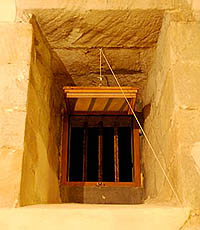  It
seems that Jean Peyrat or (aka Payrat d'Esperonnat) thought that
he had bought the entirety of both siegneuries because legal proceedings
were soon started to determine their legal owner - Jean Peyrat
claiming that he had bought both of the siegneuries and Henri
claiming to be the frightful owner of one half. Legal arguments
were to continued for several years. It
seems that Jean Peyrat or (aka Payrat d'Esperonnat) thought that
he had bought the entirety of both siegneuries because legal proceedings
were soon started to determine their legal owner - Jean Peyrat
claiming that he had bought both of the siegneuries and Henri
claiming to be the frightful owner of one half. Legal arguments
were to continued for several years.
In the end the Court of the Parliament of Toulouse favoured Henri
du Vivier. The Court gave judgement (probably on the 6th October
1668) that the Lordship of St-Julia should be detached from the
Barony of St-Ferriol. Pierre d'Esperonnat was awarded the Barronnie
de St-Ferriol including the siegneurie de Laval, the fiefs of
Moissa and Espinet, and the lands of Le Bac. Henri du Vivier was
awarded the seigneurie of Saint Julia and the forêt des
Fanges " en priage " with the King.
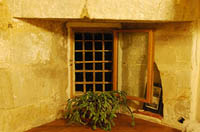  On
12 January 1665 - before the verdict - Pierre d'Esperonnat had
bought the fief of Sainte Eugénie from Arnaud Le Roi. On
12 January 1665 - before the verdict - Pierre d'Esperonnat had
bought the fief of Sainte Eugénie from Arnaud Le Roi.
Some of this division is preserved in the local government of
the area : the Commune of St Ferriol still includes Moissa and
Espinet, the lands of Le Bac and Sainte Eugénie though
Laval now belongs to Quillan and Espinet to Esperaza. Saint Julia
is a separate Commune, and the forêt Des Fanges is now owned
by Quillan.
  When
Louis du Vivier died in the middle of the seventeenth century,
he was succeeded by Henri du Vivier, who styled himself Seigneur
de St-Julia. When Barthélémy de Plaigne died without heir, the
property of the cadet branch of the de Plaigne family was left
in the hands of du Vivier, with the widow Anne de Mauléon presumably
in possession of the Chateau at St-Ferriol. When she died her
assets passed to her niece Marie de Mauléon de St-Pol. When
Louis du Vivier died in the middle of the seventeenth century,
he was succeeded by Henri du Vivier, who styled himself Seigneur
de St-Julia. When Barthélémy de Plaigne died without heir, the
property of the cadet branch of the de Plaigne family was left
in the hands of du Vivier, with the widow Anne de Mauléon presumably
in possession of the Chateau at St-Ferriol. When she died her
assets passed to her niece Marie de Mauléon de St-Pol.
The Seigneurie of St-Ferriol passed from Pierre d'Esperonnes
to his son Jean d'Esperonnes
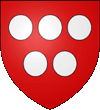    Jean
d'Esperonnes was castelan of Quillan when it burned down in 1714
destroying all the archives there. From Jean the Seigneurie passed
to François d'Esperonnes, and in the next generation to another
Pierre d'Esperonnes, who held it until the revolution. After the
revolution we find the property being sold, around 1820, to Jean-ange
Michel Bonnaventure, Marquise d'Ax, who sold it on to Antoine
Sournia around 1830. Around 1870 it was owned by François Sournia
and in 1908 was divided between his two sons, Etienne and Pierre.
From then on it was further divided by sale and inheritance. Jean
d'Esperonnes was castelan of Quillan when it burned down in 1714
destroying all the archives there. From Jean the Seigneurie passed
to François d'Esperonnes, and in the next generation to another
Pierre d'Esperonnes, who held it until the revolution. After the
revolution we find the property being sold, around 1820, to Jean-ange
Michel Bonnaventure, Marquise d'Ax, who sold it on to Antoine
Sournia around 1830. Around 1870 it was owned by François Sournia
and in 1908 was divided between his two sons, Etienne and Pierre.
From then on it was further divided by sale and inheritance.
The château itself was divided along with the land, and was used
as a farm building for many years. The north-east bastion was
used as a quarry in the early twentieth century, the stones being
used to build new houses in the village. A renaissance window
in the courtyard was enlarged to make a doorway for farm machinery,
and other external doorways were created, possibly at the same
time. The finest of the six monumental chimneys was demolished,
reputedly for resale, but the removal caused so much structural
damage that part of one pier was left intact and the other had
to be reconstructed. The present owners purchased most of the
site of the chateau in three separate purchases in 1999, and these
parts were listed soon afterwards.
|
Arms from the Commandery built by the de
Plaigne family, before the Cathar Crusade
|
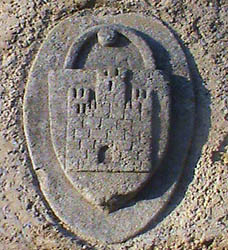 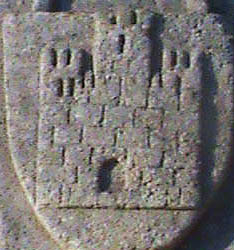 |
In 2011 we discovered an almost identical version of the presumed
arms of de Plaigne at another chateau (the Commandery) built by
the de Plaigne family near the village of Plaigne in the 12th
century. These provide convincing if not conclusive evidence that
the arms are those of de Plaigne.
|